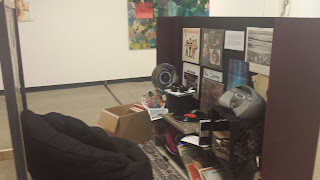At the Bakersfield Museum of Art, there are a number of exhibits that incorporate technology in their themes and their making. Many of the featured artists are students studying art at Bakersfield schools.
Ines Castillo's art addresses consumerism and materialism. In this work, the woman's eyes are replaced with barcodes, and she appears distressed. Her art shows clear influence from cartoons or comics, the former of which interested her as a child, according to her biography.
These two pieces by Allyanna Demafeliz are digital drawings. The first one,
Idealism, is a statement on how women of color are obliged by society to aspire to white standards of beauty. The second one,
Ignorantism, is a statement on how children are shielded from reality, and are often shown a distorted view of it. Most of the children have their eyes covered, and one has her mouth covered. Demafeliz has been creating digital art since she received a digital tablet at the age of 13.
Katelyn Alvarado was inspired by both Salvador Dali and animated films to create a triptych of a dreamcatcher. According to her, "I tried to change the dreamcatcher's image by making it represent man's dreams, and instead of glorifying those dreams, I wanted to show the consequences of man's accomplishments and the darkness in them."
This is a piece called Bakersfield - Water, Land, Oil by Peter Lloyd. It is a comment on how humans change the landscape around them to harvest resources for their needs. When taking this photo, I angled the reflection of the light on the ceiling so that it would appear as though the light were the sun beating down. In a sense I used my technology to create art from art.
This is my selfie at the gallery with the receptionist there.
Sources
Alvarado, Katelyn.
Untitled. 2016. Water color, ink, and colored pencil on paper. Bakersfield Museum of Art, Bakersfield, California.
Castillo, Ines.
Untitled. 2016. Water color on paper. Bakersfield Museum of Art, Bakersfield, California.
Demafeliz, Allyanna.
Idealism. 2016. Digital drawing. Bakersfield Museum of Art, Bakersfield, California.
Demafeliz, Allyanna.
Ignorantism. 2016. Digital drawing. Bakersfield Museum of Art, Bakersfield, California.
Demafeliz, Allyanna. The Art of Allyanna Demafeliz. Web. 04 June 2016.
Lloyd, Peter. Bakersfield - Water, Land, Oil. 1972. Mixed media. Bakersfield Museum of Art, Bakersfield, California.



















